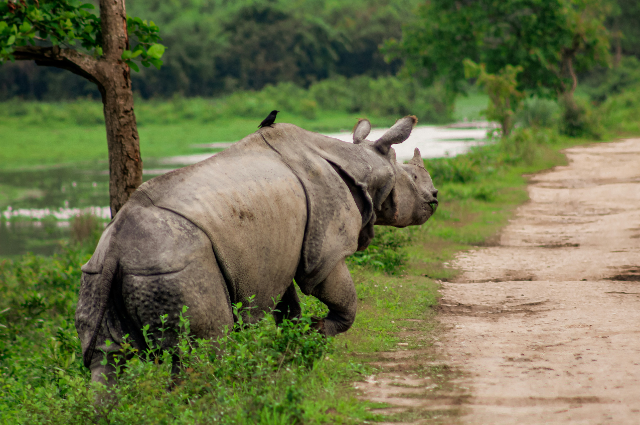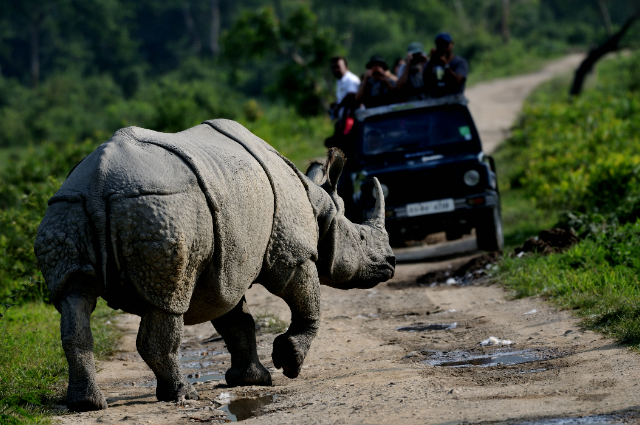
Photo by Omkar Rane on Unsplash
The greater one-horned rhinoceros (Rhinoceros unicornis), an iconic symbol of Assam’s rich biodiversity, has been a focal point of conservation efforts. This article delves into the intricacies of these efforts, highlighting the successes and challenges faced by various national parks in Assam, while providing critical insights for wildlife enthusiasts.
Kaziranga National Park:
A Conservation Triumph
Kaziranga National Park, a UNESCO World Heritage Site, is celebrated for its exceptional success in rhino conservation. Spanning approximately 1090 square kilometers, the park harbors over 2,400 rhinos, making it the largest population of one-horned rhinos in the world.
Biodiversity and Tourism:
- Wildlife Diversity: In addition to rhinos, Kaziranga is home to the Royal Bengal tiger, with its population steadily increasing due to effective management strategies. Other residents include elephants, wild buffaloes, swamp deer, and a myriad of bird species.
- Tourist Attractions: The park offers jeep and elephant safaris, providing tourists with an immersive experience. Nearby, the Kaziranga National Orchid and Biodiversity Park showcases over 500 orchid species and medicinal plants, reflecting Assam’s floral wealth and the culture of various ethnic populations and their foods. The Elephant safari is most interesting for the tourist and it starts early in the morning. Jeep safari generally starts in the afternoon. Due to flood water entering the park, the park remains closed to visitors from March to October each year.
Conservation Strategies and Challenges: Anti-Poaching Measures:
Despite stringent anti-poaching laws, the illegal rhino horn trade persists. Collaborative efforts involving local authorities, NGOs, and international partners have bolstered patrols and enforcement, but even with continuous vigilance, sometimes poaching took place .
Flood Management:
Annual floods are both a boon and a bane. While they rejuvenate the ecosystem, they also displace wildlife. Strategies such as artificial highlands and elevated platforms help mitigate these impacts, but more comprehensive flood management plans are essential. The animal crosses the highway to the other side( South) for their safety . During this time strict speed limit of the vehicle plying in the highway is enforced for safety of the animals crossing the highway for safety.
Manas National Park: Revival Amidst Challenges
Manas National Park, straddling the Assam-Bhutan border, has seen significant strides in rhino conservation. Translocation projects from Kaziranga have helped establish a burgeoning population of over 40 rhinos and covers around 850 square KM.
Biodiversity and Ecotourism:
- Wildlife Habitat: Besides rhinos, Manas is a haven for the Royal Bengal tiger, clouded leopard, Asiatic elephant, and critically endangered species like the pygmy hog.
- Tourism Potential: The park offers safari tours and river rafting, attracting eco-tourists and adventure enthusiasts. However, the influx of visitors must be managed to prevent ecological disturbances.
Critical Issues and Conservation Insights:
Infrastructure Development:
The construction of roads and other infrastructure projects, such as the road connecting Manas to Bhutan, and overcrowding of tourist poses significant threats to wildlife corridors. Conservationists argue for environmentally sensitive planning to balance development and conservation. Several vehicles passing through the park needs to be restricted immediately. the animals for fear are moving towards the Bhutan side.
Community Engagement:

Photo by santanu misra on Unsplash
Effective conservation in Manas hinges on involving local communities. Sustainable livelihood programs and awareness campaigns can foster a conservation ethic among residents, reducing human-wildlife conflicts.
Orang National Park:
Emerging Conservation Model
Orang National Park, often referred to as Mini Kaziranga, covers about 279 square kilometers along the Brahmaputra River. Recent expansions have enhanced its conservation potential, with a focus on integrating it with nearby sanctuaries.
Ecological Highlights: Rich Biodiversity:
Orang hosts rhinos, tigers, elephants, and various deer species, alongside rich avifauna.
Conservation Programs:
Initiatives aimed at controlling invasive species and improving habitat quality are pivotal in supporting a growing rhino population.
Tourism and Conservation Dynamics:
Tourist Facilities:
Orang offers wildlife viewing opportunities and is easily accessible from Tezpur. However, tourism infrastructure must be developed sustainably to avoid ecological degradation.
Conservation Challenges:
Effective management of human activities within and around the park is crucial to mitigate negative impacts on wildlife.
Critical Perspectives on Conservation Efforts
- Poaching and Illegal Trade: Despite rigorous anti-poaching laws, the demand for rhino horns in traditional medicine markets remains a formidable challenge. Conservationists advocate for international cooperation to disrupt poaching networks and reduce demand through education and stricter enforcement.
- Flooding and Habitat Loss: Annual floods, exacerbated by climate change, pose recurring threats to Assam’s wildlife. While floods are vital for maintaining the ecological balance, their increasing intensity necessitates adaptive management strategies to safeguard both wildlife and human communities.
- Development and Conservation Conflicts: Infrastructure projects within and around protected areas often lead to habitat fragmentation and increased human-wildlife conflicts. Conservationists call for a balanced approach that integrates environmental considerations into development planning, ensuring that wildlife corridors remain intact and ecosystems are preserved.
Expert Opinions and Tourist Testimonials
Wildlife Experts:
Experts underscore the importance of continuous habitat management and community involvement. Initiatives like the Indian Rhino Vision 2020 have been instrumental in reviving rhino populations, but sustained efforts are necessary to address emerging threats and ensure long-term conservation success.
Tourist Perspectives:
Visitors often commend the immersive experiences offered by Assam’s national parks, praising the well-managed safari tours and the opportunity to observe rare species in their natural habitats. However, there is a growing awareness of the need for responsible tourism practices to minimize environmental impacts and support conservation goals.
Conclusion
Assam’s national parks stand as testament to the state’s commitment to wildlife conservation. The success stories of Kaziranga, Manas, and Orang reflect the effectiveness of targeted conservation strategies, but also highlight the ongoing challenges posed by poaching, habitat loss, and infrastructure development. For wildlife enthusiasts and conservationists alike, the journey of Assam’s one-horned rhinoceros and other endangered species offers valuable lessons in resilience, collaboration, and the enduring power of nature.
By addressing these complex issues with informed strategies and sustainable practices, Assam can continue to lead the way in wildlife conservation, ensuring that its rich natural heritage is preserved for future generations.
There are many other reserve forest areas in Assam like Nambor Reserve Forest, Nameri Reserve Forest, Dibru Sikhowa National Park, Dehing-Patkai National Park etc. All are famous for their varied flora and fauna and Every effort needs to be made by the locals, policy makers park staff and most importantly the visitors so that their visit does not disturb the wildlife. Picnicking within the forest area or closed areas should be stopped willingly by the citizens as a responsibility to protect and not disturb the wildlife and birds. There are enough sources of research on the various species of plants available in these areas.
